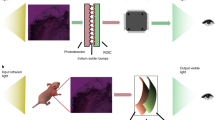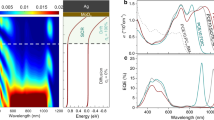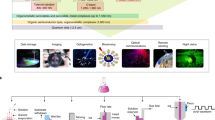Abstract
In contrast to traditional semiconductors, conjugated polymers provide ease of processing, low cost, physical flexibility and large area coverage1. These active optoelectronic materials produce and harvest light efficiently in the visible spectrum. The same functions are required in the infrared for telecommunications (1,300–1,600 nm), thermal imaging (1,500 nm and beyond), biological imaging (transparent tissue windows at 800 nm and 1,100 nm), thermal photovoltaics (>1,900 nm), and solar cells (800–2,000 nm). Photoconductive polymer devices have yet to demonstrate sensitivity beyond ∼800 nm (refs 2,3). Sensitizing conjugated polymers with infrared-active nanocrystal quantum dots provides a spectrally tunable means of accessing the infrared while maintaining the advantageous properties of polymers. Here we use such a nanocomposite approach in which PbS nanocrystals tuned by the quantum size effect sensitize the conjugated polymer poly[2-methoxy-5-(2′-ethylhexyloxy-p-phenylenevinylene)] (MEH-PPV) into the infrared. We achieve, in a solution-processed device and with sensitivity far beyond 800 nm, harvesting of infrared-photogenerated carriers and the demonstration of an infrared photovoltaic effect. We also make use of the wavelength tunability afforded by the nanocrystals to show photocurrent spectra tailored to three different regions of the infrared spectrum.
This is a preview of subscription content, access via your institution
Access options
Subscribe to this journal
Receive 12 print issues and online access
$259.00 per year
only $21.58 per issue
Buy this article
- Purchase on Springer Link
- Instant access to full article PDF
Prices may be subject to local taxes which are calculated during checkout



Similar content being viewed by others
References
Forrest, S. R. The path to ubiquitous and low-cost organic electronic appliances on plastic. Nature 428, 911–918 (2004).
Brabec, C. J. et al. A low-bandgap semiconducting polymer for photovoltaic devices and infrared diodes. Adv. Funct. Mater. 12, 709–712 (2002).
Yoshino, K. et al. Near IR and UV enhanced photoresponse of C60-doped semiconducting polymer photodiode. Adv. Mater. 11, 1382–1385 (1999).
Huynh, W. U., Dittmer, J. J. & Alivisatos, A. P. Hybrid nanorod-polymer solar cells. Science 295, 2425–2427 (2002).
Wang, Y. & Herron, N. Photoconductivity of CdS nanocluster-doped polymers. Chem. Phys. Lett. 200, 71–75 (1992).
Dabbousi, B. O., Bawendi, M. G., Onitsuka, O. & Rubner, M. F. Electroluminescence from CdSe quantum-dot/polymer composites. Appl. Phys. Lett. 66, 1316–1318 (1995).
Mattoussi, H. et al. Electroluminescence from heterostructures of poly(phenylene vinylene) and inorganic CdSe nanocrystals. J. Appl. Phys. 83, 7965–7947 (1998).
Greenham, N. C., Peng, X. & Alivisatos, A. P. Charge separation and transport in conjugated-polymer/semiconductor-nanocrystal composites studied by photoluminescence quenching and photoconductivity. Phys. Rev. B 54, 17628–17637 (1996).
Bakueva, L. et al. Size-tunable infrared (1000–1600 nm) electroluminescence from PbS quantum-dot nanocrystals in a semiconducting polymer. Appl. Phys. Lett. 82, 2895–2897 (2003).
Tessler, N., Medvedev, V., Kazes, M., Kan, S. & Banin, U. Efficient near-infrared polymer nanocrystal light-emitting diodes. Science 295, 1506–1508 (2002).
Steckel, J. S., Coe-Sullivan, S., Bulovic, V. & Bawendi, M. 1.3 μm to 1.55 μm tunable electroluminescence from PbSe quantum dots embedded within an organic device. Adv. Mater. 15, 1862–1866 (2003).
McDonald, S. A., Cyr, P. W., Levina, L. & Sargent, E. H. Photoconductivity from PbS-nanocrystal/semiconducting polymer composites for solution-processible, quantum-size tunable infrared photodetectors. Appl. Phys. Lett. 85, 2089–2091 (2004).
Hines, M. A. & Scholes, G. D. Colloidal PbS nanocrystals with size-tunable near-infrared emission: observation of post-synthesis self-narrowing of the particle size distribution. Adv. Mater. 15, 1844–1849 (2003).
Skotheim, T. A. (ed.) Handbook of Conducting Polymers (Dekker, New York, 1986).
Greenwald, Y. et al. Polymer–polymer rectifying heterojunction based on poly(3,4-dicyanothiophene) and MEH-PPV. J. Polym. Sci. A 36, 3115–3120 (1998).
Jin, S.-H. et al. Synthesis and characterization of highly luminescent asymmetric poly(p-phenylene vinylene) derivatives for light-emitting diodes. Chem. Mater. 14, 643–650 (2002).
Greczynski, G., Kugler, Th. & Salaneck, W. R. Energy level alignment in organic-based three-layer structures studied by photoelectron spectroscopy. J. Appl. Phys. 88, 7187–7191 (2000).
Brabec, C. J. et al. Origin of the open circuit voltage of plastic solar cells. Adv. Funct. Mater. 11, 374–380 (2001).
Schlamp, M. C., Peng, X. & Alivisatos, A. P. Improved efficiencies in light emitting diodes made with CdSe(CdS) core/shell type nanocrystals and a semiconducting polymer. J. Appl. Phys. 82, 5837–5842 (1997).
Ginger, D. S. & Greenham, N. C. Charge injection and transport in films of CdSe nanocrystals. J. Appl. Phys. 87, 1361–1368 (2000).
Nguyen, T.-Q., Kwong, R. C., Thompson, M. E. & Schwartz, B. J. Improving the performance of conjugated polymer-based devices by control of interchain interactions and polymer film morphology. Appl. Phys. Lett. 76, 2454–2456 (2000).
Peumans, P., Yakimov, A. & Forrest, S. R. Small molecular weight organic thin-film photodetectors and solar cells. J. Appl. Phys. 93, 3693–3723 (2003).
Acknowledgements
We thank S. Hoogland for discussions and the following for support: the Government of Ontario through the Ontario Graduate Scholarships program (S.A.M.); Materials and Manufacturing Ontario, a division of the Ontario Centres of Excellence; the Natural Sciences and Engineering Research Council of Canada through its Collaborative Research and Development Program; Nortel Networks; the Canada Foundation for Innovation; the Ontario Innovation Trust; and the Canada Research Chairs Programme.
Author information
Authors and Affiliations
Corresponding author
Ethics declarations
Competing interests
The authors declare no competing financial interests.
Supplementary information
Supplementary Information
Supplementary Information, Fig S1 (PDF 69 kb)
Rights and permissions
About this article
Cite this article
McDonald, S., Konstantatos, G., Zhang, S. et al. Solution-processed PbS quantum dot infrared photodetectors and photovoltaics. Nature Mater 4, 138–142 (2005). https://doi.org/10.1038/nmat1299
Received:
Accepted:
Published:
Issue Date:
DOI: https://doi.org/10.1038/nmat1299
This article is cited by
-
Wafer-scale transistor arrays fabricated using slot-die printing of molybdenum disulfide and sodium-embedded alumina
Nature Electronics (2023)
-
Single PbS colloidal quantum dot transistors
Nature Communications (2023)
-
Efficient quantum dot infrared solar cells with enhanced low-energy photon conversion via optical engineering
Nano Research (2023)
-
Size-dependent of plasmonic gold nanoparticles enhanced on WS2/Si nanohybrids photodetector
Journal of Materials Science: Materials in Electronics (2023)
-
Heterogeneous system synthesis of high quality PbS quantum dots for efficient infrared solar cells
Nano Research (2023)



